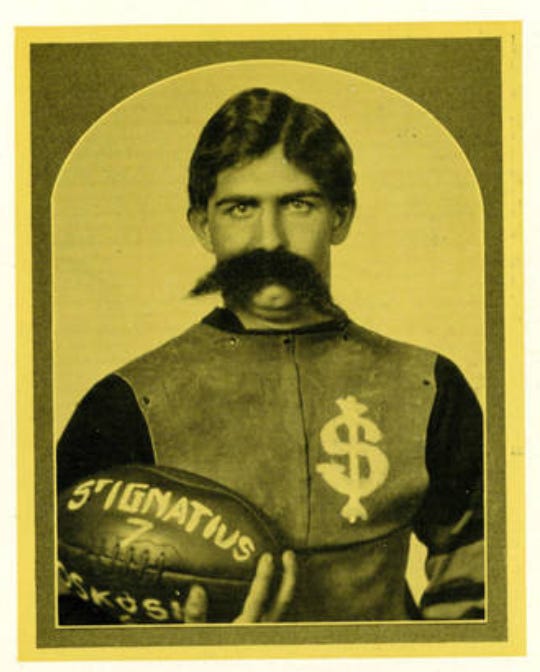Stadium Size, Football Droppers, and Deemphasizers: San Francisco
This series reviews the program history and stadiums of colleges that dropped or deemphasized football. The schools included in the review are listed below.
St. Ignatius College in San Francisco played football here and there before the forward pass came along, but like many schools in California, they did not play the game from 1906 through 1916.
Renamed the University of San Francisco in 1930, the school returned to the gridiron in 1917. The team played its games at St. Ignatius Stadium, which adjoined campus, for several years. While the site now hosts a soccer stadium under a different name, images, and information about its capacity in the early 1920s are unavailable.
Starting in 1924, St. Ignatius played most home games at nearby Ewing Field, home of the minor league San Francisco Seals, which burned in 1926. The St. Ignatius Gray Fog moved their games to Kezar Stadium, which led to challenges in booking dates, with several other Bay Area schools playing and one less stadium to go around.
Through the 1920s and 1930s, St. Ignatius, then USF, was a decidedly mid-major program and a losing one. They played one of two games per year against Stanford, Oregon State, or an Eastern team looking for a West Coast trip and only one game east of the Rockies until 1948.
USF played its most competitive football after WWII, primarily due to hiring Joe Kuharich as head coach. A former Notre Dame and Chicago Cardinals player, Kuharich coached three different NFL teams and Notre Dame after leaving San Francisco. Kuharich had little to offer players besides room and board in former ROTC quarters but had success or luck finding diamonds in the rough as they churned out many AAFC and NFL draft choices.
The 1950 team went 7-4, losing to two Top 10 and another Top 20 team, but the Dons struck it rich in 1951 with a team that featured ten NFL draft choices, including three Pro Football Hall of Famers: Gino Marchetti, Ollie Matson, and Bob St. Clair. Their only close game was a 32-26 win at Fordham, and they finished 9-0 and ranked #13 by the AP.

Their success led to an Orange Bowl invitation, which the team turned down due to an Orange Bowl policy that banned USF's two Black players from participating. Ollie Matson, a fullback, earned All-Pro honors seven times, while his counterpart, Burl Toler, was drafted but did not play in the NFL. Still, he became the NFL's first Black game official in 1965.
Another notable figure in San Francisco's athletic program was a 1950 graduate and publicity director, Alvin Rozelle, who went by Pete. He receives credit for the team gaining substantial publicity, especially on their visit to New York to play Fordham.
Unfortunately for the USF Dons, the 1951 team ran a $70,000 deficit. While the Dons attracted three to four home crowds exceeding 30,000 fans in the 1930s, especially for games against St. Mary's, Santa Clara, and San Jose, St. Mary's dropped football in 1950 and 1951 saw only one crowd of 30,000 or more. Their once loyal fans found the San Francisco 49ers more attractive, especially after they joined the NFL in 1950.
So, despite having their best season ever and finishing the year ranked in the Top 20, the University of San Francisco dropped football after the 1951 season. The school later brought football back at the Division II level, lasting only a few years.
2024 Concept Uniform
My brother, Steve, dabbles in sports team logos and uniforms. Here are his concept uniforms for San Francisco’s imaginary 2024 team.
Next up: Denver U.
Ranking by Stadium Size
Below are the schools reviewed to date, ranked by stadium size. The stadiums’ opening and demolition years (if applicable) are also noted.
Catholic (Brookland Stadium): 30,000 | 1924 - 1985
Denver (DU/Hilltop Stadium): 30,000 | 1925 - 1971
Marquette (Marquette Stadium): 24,000 | 1924 - 1977
Xavier (Corcoran Stadium): 15,000 | 1929 - 1988
Gonzaga (Gonzaga Stadium): 12,000 | 1922 - 1949
California State University, Fullerton (Titan Stadium): 10,000 | 1992 - TBD
Boston University (Nickerson Field): 10,000 | 1915 - TBD
Vermont (Centennial Field): 10,000 | 1923 - TBD
NYU (Ohio Field): 5,000 (est.) | 1897 - 1947
San Francisco (St. Ignatius Stadium): <5,000 (est.) | c. 1909 - c. 1930
Carnegie-Mellon (Skibo Bowl): 4,500 | 1960 - 1987 | Gesling Stadium: 3,900 | 1990 - TBD
Sewanee (McGee Field): 3,000 | 1891 - TBD
Schools to Review
California State University, Long Beach | University of California, Santa Barbara | Case Western | Chicago | CCNY | Creighton | DePaul | Detroit | Drake | Loyola (Chicago) | Nebraska-Omaha | Pacific | St. Louis | Santa Clara | Tampa | Washington University in St. Louis | Wichita State
Click here for options to support this site beyond a free subscription.









Pete Rozelle, of course, would eventually spend a lengthy term as President of the NFL.